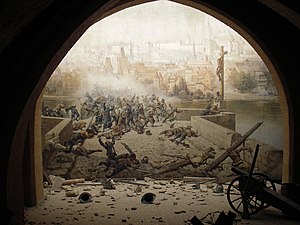Battle of Prague (1648)
| Battle of Prague | |||||||
|---|---|---|---|---|---|---|---|
Part of the Thirty Years' War
 | |||||||
| |||||||
| Belligerents | |||||||
|
|
| ||||||
| Commanders and leaders | |||||||
|
|
| ||||||
| Strength | |||||||
| cca 7500 soldiers (unconfirmed) plus 6000 reinforcements led by Charles X Gustav of Sweden | cca 2000 soldiers, plus local militia and Academic Legion | ||||||
| Casualties and losses | |||||||
| 500 dead, 700 wounded | 219 dead, 475 wounded | ||||||
The Battle of Prague, which occurred between 25 July and 1 November 1648 was the last action of the Thirty Years' War. While the negotiations for the Peace of Westphalia were proceeding, the Swedes took the opportunity to mount one last campaign into Bohemia. The main result, and probably the main aim, was to loot the fabulous art collection assembled in Prague Castle by Rudolph II, Holy Roman Emperor (1552–1612), the pick of which was taken down the Elbe in barges and shipped to Sweden.[1]
After occupying the castle and the western bank of the Vltava for some months, the Swedes withdrew when news of the signing of the treaty reached them.
Overview
General Hans Christoff von Königsmarck, commanding Sweden's flying column, entered the city, which was defended by the Governor Feldmarschall Rudolf von Colloredo, a veteran of the siege of Mantua and of the battle of Lutzen, where he served under Albrecht von Wallenstein. The Swedes captured Prague Castle, a sprawling palace complex, on the western bank of the Vltava river and attempted to enter the Old Town on the eastern bank of the river, but were repulsed on the Charles Bridge by Colloredo's men. When a third Swedish army commanded by Prince Carl Gustaf came close to Prague, all three Swedish armies launched a number of attacks against the city. These attacks were resisted, largely thanks to the skill of the Feldmarschall and the energy of his troops. When in November Gustaf received a report about the signed peace, he ordered his troops to leave.
Unable to enter the city, the Swedes settled for looting the castle; some have argued that this was the main purpose of the raid. Many of the treasures collected by Emperor Rudolf II (such as the Codex Gigas and Codex Argenteus) were taken to Sweden, where some can be found in Drottningholm Palace, for example several statues by Adrien de Vries.[2] The cream of the artworks were taken into exile by Christina, Queen of Sweden, and dispersed in groups after her death, the paintings forming the core of the Orleans Collection, which was sold in London after the French Revolution, so that many of Rudolf's paintings are now in the United Kingdom. A Swedish inventory of 1652 lists 472 paintings as having come from Prague.[3]
Monument
A monument erected during the 19th century on Colloredo's tomb in the Church of the Maltese Order in Prague recalls his victory over the Swedes. Its German inscription reads thus:
HIER RUHT RUDOLF GRAF COLLOREDO K.K. FELDMARSCHALL UND MALTHESERORDER GROSSPRIOR Vertheididiger der Alt und Neusstad Prags gegen die Schweden Geb. Am 2 Nov. 1585 Gest. Am 27 Jan. 1657.
("Here lies Rudolf, count Colloredo, Imperial and Royal Feldmarshall and Grand Prior of the Order of Malta, defender of the Old and New Town of Prague against the Swedes. Born 2. Nov. 1585 Dead 27 Jan. 1657")
On Charles Bridge a 17th-century Latin inscription says:
SISTE VIATOR, SED LUBENS, AC VOLENS UBI SISTERE DEBUIT, SED COACTUS GOTHORUM, AC VANDALORUM FUROR
"Rest here, walker, and be happy: you can stop here willing, but unwilling were stopped the Goths (Swedes) and their Vandalic ferocity"
Notes
References
- Watson, Peter; Wisdom and Strength, the Biography of a Renaissance Masterpiece, Hutchinson, 1990, ISBN 009174637X
